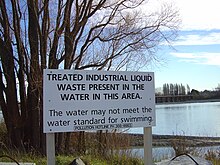
Water pollution in New Zealand is an increasing concern for those who use and care for waterways and for New Zealand regulatory bodies.[1] An increase in population is linked to an increase in water pollution, due to a range of causes such as rural land use, industrial use and urban development.[2] Fresh water quality is under pressure from agriculture, hydropower, urban development, pest invasions and climate change.[3] While pollution from point sources has been reduced, diffuse pollution such as nutrients, pathogens and sediments development and from stormwater in towns is not under control. There are more than 800 water quality monitoring sites around New Zealand that are regularly sampled.[4]
As of January 2019[update], Auckland is the region with New Zealand's most polluted waterways, with 62% of rivers and lakes graded poor by the Ministry for the Environment for swimming, and 0% of rivers and lakes graded as good.[5]
In 2018, waterways across New Zealand have been showing improvements across a number of water quality measures, as monitored by LAWA data.[6]
- ^ Piddock, Gerald (2 January 2019). "Water pollution the number one concern for New Zealanders in new poll". Stuff.
- ^ Our Freshwater 2020. Ministry for the Environment and Stats NZ. 16 April 2020.
- ^ Gluckman, Sir Peter (12 April 2017). "New Zealand's Fresh Waters" (PDF). Prime Minister’s Chief Science Advisor.
- ^ Environment Aotearoa 2015. Ministry for the Environment. October 2015. ISBN 978-0-478-41298-7.
- ^ "Rivers and lakes in Auckland Region". Ministry for the Environment. Retrieved 16 January 2019.
- ^ Taunton, Esther (29 April 2018). "Freshwater quality improving nationwide, report shows". Stuff.